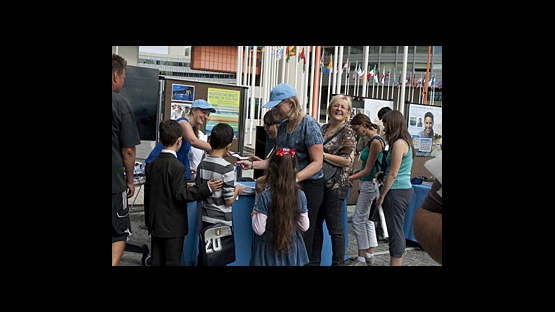Crowding around tables packed with IAEA information materials and instruments used to measure radiation, visitors waiting for free guided tours at a recent Open Day at the Vienna International Centre bounced off questions about the Agency, nuclear matters and radiation in general.
IAEA staff not only responded to the questions, but also posed some of their own: visitors were invited to answer quiz questions related to the Agency and its work for the chance to win small prizes. Participants young and old deduced the answers with the help of the information at the tables, and hints from IAEA staff.
"Yksi, kaksi, kolme, neljä...," a little girl counted in her native Finnish to determine just how many electrons are part of the atom in the IAEA's emblem, earning her a ballpoint pen emblazoned with the IAEA logo.
"The IAEA won a Nobel Peace Prize for Peace in 2005," an Austrian retiree exclaimed, happy to have answered correctly.
More than 2 000 people visited the Vienna International Centre to take free guided tours offered by the United Nations Information Service (UNIS) in Vienna as part of the Open Day, held to mark the 35th anniversary of the iconic building. While waiting for the tours, many took a chance to browse information displays set up by the IAEA and other Vienna-based international organisations.
A popular feature was the opportunity to be photographed in front of a blue backdrop featuring the IAEA logo. The photos of the visitors, some posing in serious, statesman-like manners and others smiling widely, form part of a photo album on the IAEA Facebook page.
At the IAEA's display, Incident and Emergency Assessment Officer Joseph Chaput demonstrated how instruments that measure radiation are used, showing how telescopic probes and protective suits can help ensure that those who work in environments with radioactive material are exposed to as low a radiological dose as possible.
"Our visitors asked questions about how the equipment would be used to measure radiation during a radiological or nuclear incident or emergency," he said. "We also received a lot of questions about radiation in general - some were surprised to hear that there is background radiation everywhere in the environment, so we spent some time explaining how radiation occurs naturally."


